Not singing in the rain: How climate change and increasing precipitation put a damper on songbird populations
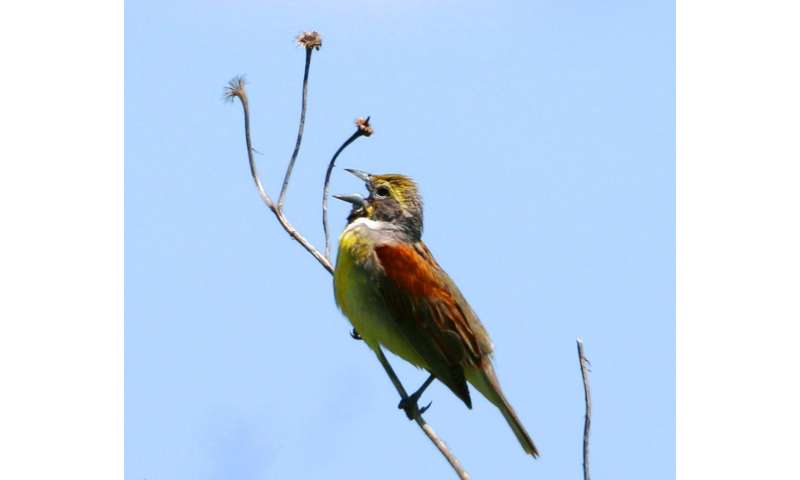
North American grassland bird populations have decreased over 50% in the past 50 years, more than any other group of birds on the continent. What is driving these steep declines?
"Not enough research has been done on grassland birds relative to their importance for conservation. It is vital that we learn more about this suite of birds because of the varying responses each species has to environmental change," explained Kristen Rosamond, Rose Research Fellow at the International Bird Conservation Partnership.
Iconic grassland birds with a boisterous song, dickcissels' bright yellow and black chests make them easily recognizable on their summer nesting grounds in the North American Great Plains. While dickcissel populations are not currently declining overall, they have declined significantly in the recent past and are considered highly vulnerable to habitat loss, anthropogenic disturbance and climate change.
Dickcissel populations are higher when it's drier
Dickcissels nest in the Platte River Valley, Nebraska, a region where climate change has been driving higher levels of precipitation, including historic flooding in 2019. In a new study published in Frontiers in Ecology and Evolution, Rosamond and her colleagues investigated factors associated with changes in dickcissel abundance and productivity in this area using nine years of bird banding data collected between 2002 and 2019.
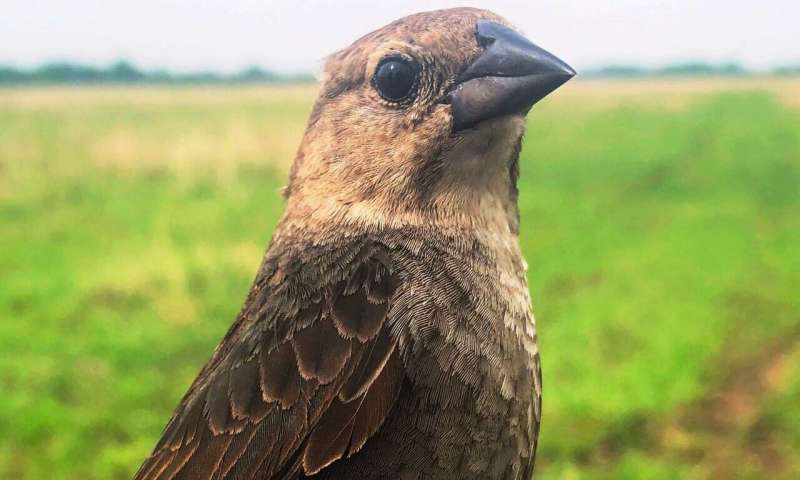
"We found that higher June precipitation is correlated with lower numbers of adult dickcissels," reported Rosamond. "Flooding, summer hailstorms and changes in exposure to predators are some of the factors that may be driving this relationship." Previous research has shown that other grassland songbirds, such as grasshopper sparrows, show the same pattern of declining abundance with increasing rainfall.
Breeding dickcissels also face an additional challenge: brood parasitism by brown-headed cowbirds. Rather than making their own nests, cowbirds have evolved to lay their eggs in the nests of other songbirds and remove eggs from their hosts' nests. Cowbirds intensely parasitize dickcissels throughout much of their breeding range, causing dickcissels to spend energy and resources raising cowbirds at the expense of their own offspring.
Cowbird populations do better when it's wetter
Before European settlement of the Great Plains, cowbirds, or "buffalo birds," followed enormous herds of American bison, which were migratory and highly mobile. Cowbirds were thus likely also nomadic to a large extent, and their impacts on the productivity of songbirds hosting their eggs likely ephemeral. Following the near-extinction of bison and the subsequent conversion of much of the Great Plains to agriculture and ranchlands with introduced cattle, cowbirds have adapted to the times by becoming more sedentary during the songbird breeding season. This change may have magnified their effects on their hosts, as cowbirds' excellent memories allow them to learn many host nest locations and visit them repeatedly.
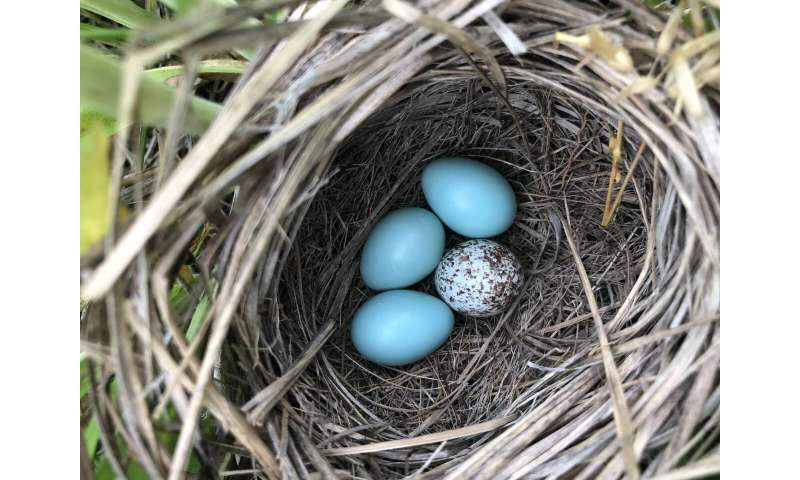
Rosamond and her colleagues found that increasing precipitation is correlated with a higher abundance of adult and juvenile cowbirds. Higher rainfall contributes to greater plant growth and food availability that may benefit cowbirds and other species. But because higher rainfall means more cowbirds and fewer dickcissels, it may also mean that dickcissels are more vulnerable to cowbird parasitism, as larger numbers of cowbirds parasitize smaller numbers of dickcissel nests in the same breeding area.
Where have all the females gone?
Dickcissel productivity, or the number of offspring they produce, is also limited by the number of breeding females. "We found a 3:1 ratio of males to females in our study area," said Rosamond, "and juveniles only represented 4% of the total number of dickcissels we captured," said Rosamond. Previous studies have also identified male-biased sex ratios in dickcissel populations, which may increase with breeding latitude and may have increased over time.
The mechanism driving the higher prevalence of males, which are larger than females, remains unknown but is an area of inquiry ripe for future research. Proposed hypotheses include conversion of grasslands to agricultural crops on their wintering grounds that are more conducive to male survival, and higher cold tolerance of males on their northern breeding grounds due to their larger size. Whatever is driving the low numbers of females also contributes to the low number of juvenile dickcissels in this ecosystem.
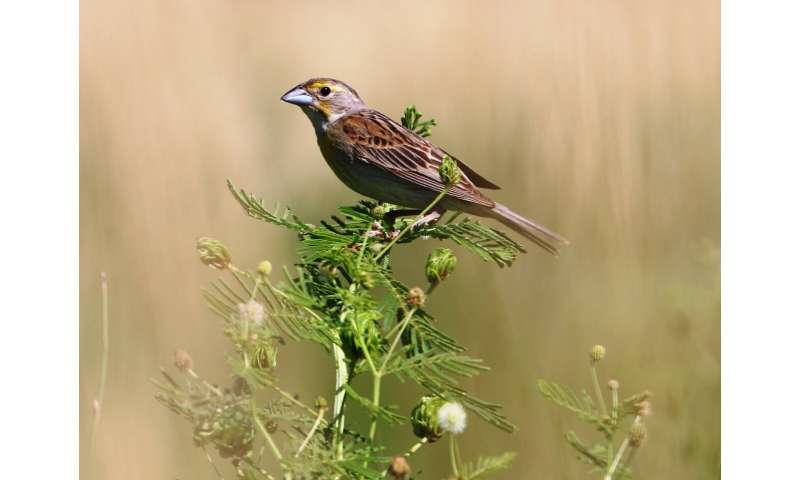
What does the future hold?
Climate change is expected to bring more precipitation to this region of the North American Great Plains in the future, which could be detrimental for dickcissels, grasshopper sparrows and other grassland birds negatively affected by higher levels of precipitation. Protecting grasslands from further conversion to agriculture will be critical for grassland bird conservation, together with sound adaptive management to further birds' survival and nest success.
Important steps land managers can take to help birds include timing hay harvests to avoid the songbird breeding season, for example, giving grassland nesting birds precious time to raise their chicks. Ongoing research on how climate variation affects songbirds, including their relationships with cowbirds, will be important for informing other grassland management strategies to promote bird conservation.
"It is important to realize that even though dickcissels are not currently listed as endangered, they are still very vulnerable to anthropogenic change," Rosamond said.
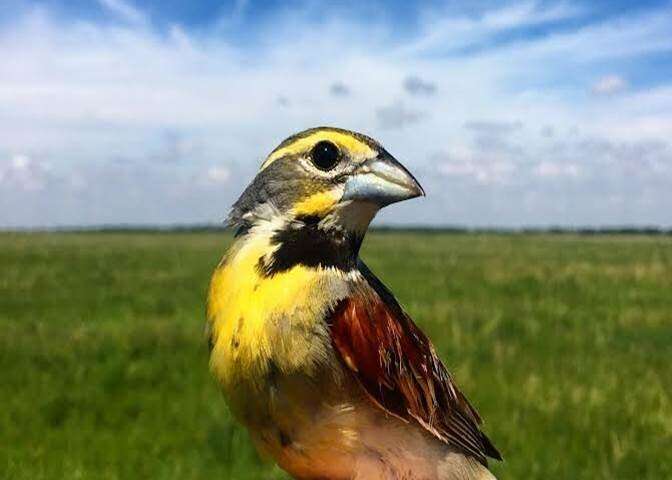
"We hope the findings presented here will inform future research and adaptive management so that our grasslands keep ringing with their songs far into the future."
This story is part of Science X Dialog, where researchers can report findings from their published research articles. Visit this page for information about ScienceX Dialog and how to participate.
More information:
Rosamond et al., Not singing in the rain: linking precipitation increases and brood parasitism vulnerability to migratory songbird declines. Frontiers in Ecology and Evolution (2020). DOI: 10.3389/fevo.2020.536769 , www.frontiersin.org/articles/1 … 2020.536769/abstract
Kristen Rosamond is Rose Research Fellow at the International Bird Conservation Partnership (IBCP), which fosters and supports research, education, and partnerships to promote the conservation of birds worldwide. She earned her BS and MS from Tulane University, during which she studied relationships between the morphology and foraging behaviors of warblers. Her main interests focus on the ecology and conservation of birds, in particular shorebirds and seabirds, and scientific outreach and education. Nico Arcilla is Research Director of IBCP and Affiliate Fellow at the University of Nebraska. She earned her BA from Yale University, MS from Cornell University, and PhD from the University of Georgia, and has led bird ecology research and conservation projects at the Smithsonian Institution, Zoological Society of London, and Drexel University.